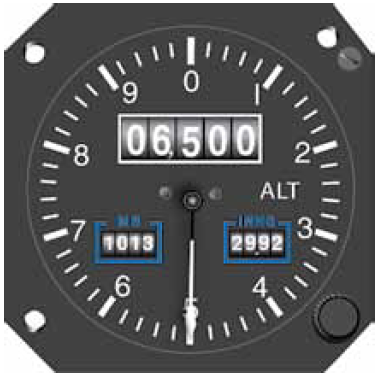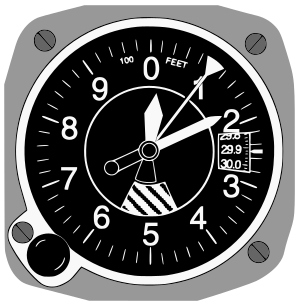用戶:StephDC/Sandbox0
高度計是用來測量物體水平高度,即海拔的工具。高度的測量被稱為測高,與測深,即測量水下深度類似。
目錄
氣壓高度計
海拔高度可通過測量大氣壓得到。當一隻氣壓表被標上與海拔高度的氣壓一致的非線性刻度時,這個氣壓表即可被稱爲氣壓高度計或大氣高度計。氣壓高度計是在飛行器上最常見的高度計,而跳傘玩家也常使用綁在腰上的氣壓高度計來做類似用途。登山者常用繫在手腕上或手持式的高度計以幫助他們使用地圖、指南針或GPS定位。
氣壓高度計的校準可以使用以下公式進行:
- <math>z=c\;T\;\log(P_o/P),</math>[1]
此時 c 為常數, T 為絕對溫度, P 為在高度 z 處的氣壓,而 P0 為在海平面處的大氣壓。常數 c 與重力加速度和空氣的摩爾質量相關。
但是,由於氣壓高度計基於「密度高度」,而所指示的數值可以在受到類似冷鋒面氣流衝擊等而發生瞬時氣壓改變時輕易產生數百英尺的誤差。[2]
在登山運動上的應用
一隻氣壓高度計在與等高線地圖共同使用時可以幫助確認當前的地理位置。通常情況下,氣壓高度計在用於測量海拔時,比起GPS高度計要更加可靠並且準確,因為GPS高度計在例如峽谷底部等地可能不可用,或在例如所有可用衛星都在地平線附近時給出具有極大誤差的數據。而由於大氣壓會隨着天氣的變化而變化,因此登山者需要每到一個已知的高度時,例如到達路線交叉點或於等高線地圖上標明的峰頂時就重新校準氣壓高度計。
在飛行器上的應用

In aircraft, an aneroid barometer measures the atmospheric pressure from a static port outside the aircraft. Air pressure decreases with an increase of altitude—approximately 100 hectopascals per 800 meters or one inch of mercury per 1000 feet near sea level.
The aneroid altimeter is calibrated to show the pressure directly as an altitude above mean sea level, in accordance with a mathematical model defined by the International Standard Atmosphere (ISA). Older aircraft used a simple aneroid barometer where the needle made less than one revolution around the face from zero to full scale. This design evolved to altimeters with a primary needle and one or more secondary needles that show the number of revolutions, similar to a clock face. In other words, each needle points to a different digit of the current altitude measurement. However this design has fallen out of favor due to the risk of misreading in stressful situations. The design evolved further to drum-type altimeters, the final step in analogue instrumentation, where each revolution of a single needle accounted for 1,000 feet, with thousand foot increments recorded on a numerical odometer-type drum. To determine altitude, a pilot had first to read the drum to determine the thousands of feet, then look at the needle for the hundreds of feet. Modern analogue altimeters in transport aircraft are typically drum-type. The latest development in clarity is an Electronic flight instrument system with integrated digital altimeter displays. This technology has trickled down from airliners and military planes until it is now standard in many general aviation aircraft.
Modern aircraft use a "sensitive altimeter,". On a sensitive altimeter, the sea-level reference pressure can be adjusted with a setting knob. The reference pressure, in inches of mercury in Canada and the US and hectopascals (previously millibars) elsewhere, is displayed in the small Kollsman window,[3] on the face of the aircraft altimeter. This is necessary, since sea level reference atmospheric pressure at a given location varies over time with temperature and the movement of pressure systems in the atmosphere.
In aviation terminology, the regional or local air pressure at mean sea level (MSL) is called the QNH or "altimeter setting", and the pressure that will calibrate the altimeter to show the height above ground at a given airfield is called the QFE of the field. An altimeter cannot, however, be adjusted for variations in air temperature. Differences in temperature from the ISA model will accordingly cause errors in indicated altitude.
In aerospace, the mechanical stand-alone altimeters which are based on diaphragm bellows were replaced by integrated measurement system which is called Air data computer (ADC). This module measures altitude, speed of flight and outside temperature to provide more precise output data allowing automatic flight control and Flight level division. Multiple altimeters can be used to design a Pressure Reference System to provide information about airplane's position angles to further support Inertial navigation system calculations.
在地面效應載具中的使用
經過廣泛的研究和實驗,已經證明相對於激光、各向同性或超聲波測高計,「相無線電測高計」是最適合地面效應載具。[4]
聲波高度計
1931年,美國陸軍航空隊和通用電氣測試了一款為飛機設計的聲波高度計,在雨天或者霧天這款測高儀有着明顯高於空氣壓力高度計的精確度。這款聲波高度計採用了類似蝙蝠的高頻聲波來衡量飛機與地面的距離,並轉換成以英尺表示的數值顯示在飛機上的一個儀錶盤里。[5]
雷達高度計
雷達高度計測量高度的方法更加直接:通過計算一個無線電訊號從地面反射回來的時間來判斷高度。現在雷達高度計一般用於商用或軍用飛機降落時的高度測量和警告飛行員高度過低或者前方有上升地形。後者通常用於一些低空飛行的戰鬥機。
GPS
全球衛星定位系統(GPS)接收器也可以通過與四個或更多的衛星進行三邊測量來判斷高度。但在飛機上,如果不使用一些方法來提高精確度,GPS本身的精確度並無法取代壓力測高儀。在徒步旅行或者登山時,我們經常可以發現GPS測量的高度誤差可以達到1000米以上。當所有可用的衛星都接近地平線時GPS也會無法使用。
Other modes of transport
The altimeter is an instrument optional in off-road vehicles to aid in navigation. Some high-performance luxury cars that were never intended to leave paved roads, such as the Duesenberg in the 1930s, have also been equipped with altimeters.
Hikers and mountaineers use hand-held or wrist-mounted barometric altimeters, as do skydivers.
Diesel submarines have barometers installed on them to monitor vacuum being pulled in the event that the snorkel closes while the diesels are running and, as a consequence, sucking the air out of the boat.
Satellites

Many satellites (see links) use advanced dual-band radar altimeters to measure height from a spacecraft. That measurement, coupled with orbital elements (possibly augmented by GPS), enables determination of the terrain. The two different wavelengths of radio waves used permit the altimeter to automatically correct for varying delays in the ionosphere.
Spaceborne radar altimeters have proven to be superb tools for mapping ocean-surface topography, the hills and valleys of the sea surface. These instruments send a microwave pulse to the ocean's surface and record the time it takes to return. A microwave radiometer corrects any delay that may be caused by water vapor in the atmosphere. Other corrections are also required to account for the influence of electrons in the ionosphere and the dry air mass of the atmosphere. Combining these data with the precise location of the spacecraft makes it possible to determine sea-surface height to within a few centimetres (about one inch). The strength and shape of the returning signal also provides information on wind speed and the height of ocean waves. These data are used in ocean models to calculate the speed and direction of ocean currents and the amount and location of heat stored in the ocean, which in turn reveals global climate variations.
See also
- Acronyms and abbreviations in avionics
- Flight instruments
- Flight level
- seasat, TOPEX/Poseidon are satellites that deployed extremely accurate altimeters
- United Airlines Flight 389, an accident attributed to misreading of an altimeter
- Turkish Airlines Flight 1951, an accident attributed to a malfunctioning radio altimeter
- Jason-1, Ocean Surface Topography Mission/Jason-2 are current satellite missions that use altimeters to measure sea surface height
References
- ↑ http://www.hills-database.co.uk/altim.html
- ↑ "How Aircraft Instruments Work." Popular Science, March 1944, p. 118.
- ↑ http://www.stolaf.edu/people/hansonr/soaring/altimetr.htm
- ↑ Nebylov, Prof. Alexander and Sharan Sukrit. "Comparative Analysis Of Design Variants For Low Altitude Flight Parameters Measuring System". 17th IFAC Symposium for Automatic Control.
- ↑ "Meter Gives Elevation", Popular Science, March 1931
External links
- MS5561C Micro Altimeter for GPS, 1m resolution
- History of the Kollsman altimeter
- A Flash 8 based simulator for altimeter errors caused by variations in temperature and pressure
- The use of altimeters in height measurement – for hillwalkers
- Compact digital pressure sensor for altimeters
- Early use of barometers on surveys
- The altimeter and the types of altitude
- Evolution of the Modern Altimeter – Flight archive
Template:Flight instruments Template:Aircraft components Template:Aviation lists

